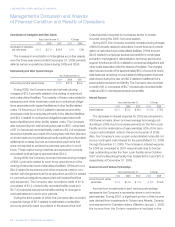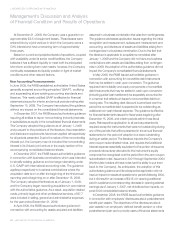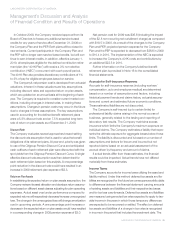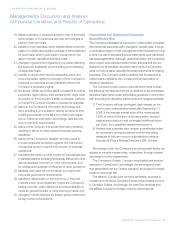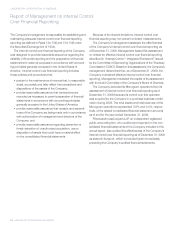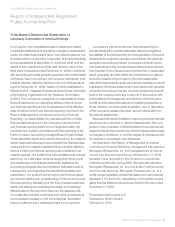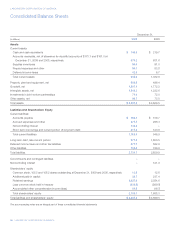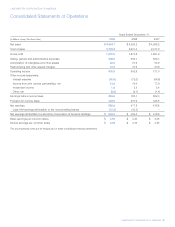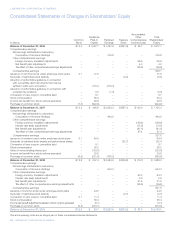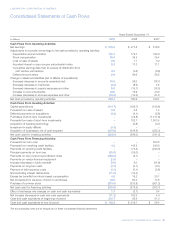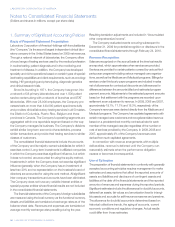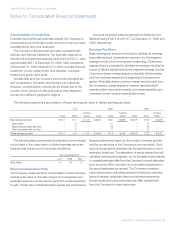LabCorp 2009 Annual Report Download - page 33
Download and view the complete annual report
Please find page 33 of the 2009 LabCorp annual report below. You can navigate through the pages in the report by either clicking on the pages listed below, or by using the keyword search tool below to find specific information within the annual report.LABORATORY CORPORATION OF AMERICA
Management’s Discussion and Analysis
of Financial Condition and Results of Operations
LABORATORY CORPORATION OF AMERICA 31
In October 2009, the Company received approval from its
Board of Directors to freeze any additional service-based
credits for any years of service after December 31, 2009 on
the Company Plan and the PEP. Both plans will be closed to
new entrants. Current participants in the Company Plan and
the PEP will no longer earn service-based credits, but will con-
tinue to earn interest credits. In addition, effective January 1,
2010, all employees eligible for the defined contribution retire-
ment plan (the “401K Plan”) will receive a 3% non-elective
contribution (“NEC”) concurrent with each payroll period.
The 401K Plan also provides discretionary contributions of 1%
to 3% of pay for eligible employees based on service.
The Company’s net pension cost is developed from actuarial
valuations. Inherent in these valuations are key assumptions,
including discount rates and expected return on plan assets,
which are updated on an annual basis at the beginning of each
year. The Company is required to consider current market con-
ditions, including changes in interest rates, in making these
assumptions. Changes in pension costs may occur in the future
due to changes in these assumptions. The key assumptions
used in accounting for the defined benefit retirement plans
were a 5.8% discount rate and an 7.5% expected long-term
rate of return on plan assets as of December 31, 2009.
Discount Rate
The Company evaluates several approaches toward setting
the discount rate assumption that is used to value the benefit
obligations of its retirement plans. At year-end, priority was given
to use of the Citigroup Pension Discount Curve and anticipated
cash outflows of each retirement plan were discounted with the
spot yields from the Citigroup Pension Discount Curve. A single-
effective discount rate assumption was then determined for
each retirement plan based on this analysis. A one percentage
point reduction in the discount rate would have resulted in an
increase in 2009 retirement plan expense of $3.3.
Return on Plan Assets
In establishing its expected return on plan assets assumption, the
Company reviews its asset allocation and develops return assump-
tions based on different asset classes adjusting for plan operating
expenses. Actual asset over/under performance compared to
expected returns will respectively decrease/increase unrecognized
loss. The change in the unrecognized loss will change amortization
cost in upcoming periods. A one percentage point increase or
decrease in the expected return on plan assets would have resulted
in a corresponding change in 2009 pension expense of $2.0.
Net pension cost for 2009 was $36.6 (including the impact
of the $2.8 non-recurring net curtailment charge) as compared
with $19.5 in 2008. As a result of the changes to the Company
Plan and PEP, projected pension expense for the Company
Plan and the PEP is expected to decrease from $36.6 in 2009
to $10.4 in 2010. The implementation of the NEC is expected
to increase the Company’s 401K costs and contributions by
an additional $22.5 in 2010.
Further information on the Company’s defined benefit
retirement plan is provided in Note 16 to the consolidated
financial statements.
Accruals for Self-Insurance Reserves
Accruals for self-insurance reserves (including workers’
compensation, auto and employee medical) are determined
based on a number of assumptions and factors, including
historical payment trends and claims history, actuarial assump-
tions and current and estimated future economic conditions.
These estimated liabilities are not discounted.
The Company is self-insured (up to certain limits) for
professional liability claims arising in the normal course of
business, generally related to the testing and reporting of
laboratory test results. The Company maintains excess
insurance which limits the Company’s maximum exposure on
individual claims. The Company estimates a liability that repre-
sents the ultimate exposure for aggregate losses below those
limits. The liability is discounted and is based on a number of
assumptions and factors for known and incurred but not
reported claims based on an actuarial assessment of the
accrual driven by frequency and amount of claims.
If actual trends differ from these estimates, the financial
results could be impacted. Actual trends have not differed
materially from these estimates.
Income Taxes
The Company accounts for income taxes utilizing the asset and
liability method. Under this method deferred tax assets and lia-
bilities are recognized for the future tax consequences attributable
to differences between the financial statement carrying amounts
of existing assets and liabilities and their respective tax bases
and for tax loss carryforwards. Deferred tax assets and liabilities
are measured using enacted tax rates expected to apply to tax-
able income in the years in which those temporary differences
are expected to be recovered or settled. The effect on deferred
tax assets and liabilities of a change in tax rates is recognized
in income in the period that includes the enactment date. The





